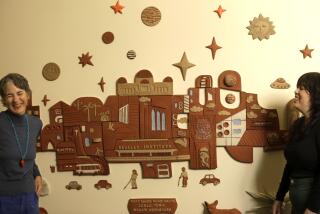Computers Revolutionize Printing in Braille
- Share via
PHILADELPHIA — May Davis and Roy DiFonzo are reading a Sherlock Holmes mystery. They trade off reading paragraphs aloud as they work through the tale chapter by chapter.
But Roy is reading from the original bound volume of the story, while May, blind since the age of 3, reads from the square sheets of Braille beneath her fingertips.
The two are proofreaders at the Jenny Beck Braille Center in Philadelphia, one of only five Braille printing facilities in the country that produce reading material for the blind.
Along with printing plants in Boston, Chicago, Louisville, Ky., and Stewart, Fla., the Jenny Beck Braille Center prints the bulk of this country’s Braille books and pamphlets, music and magazines, artwork and math text.
“We produce an average of 100 books each year,” says center director Dolores Ferrara-Godzieba. “But we also print brochures and pamphlets, approximately 10,000 bank statements each year and any piece of custom Braille work that comes our way.”
In the process, the printing facility for the blind brought in $1.1 million in revenue last year.
In the early 1800s, a 15-year-old blind French student named Louis Braille developed the code of raised dots that came to bear his name. Shortly thereafter, the young man created a metal slate and stylus to print Braille dot by dot, letter by letter.
Braille printing is still a labor-intensive process and in many places relies on a six-key typewriter called a Braillewriter, but computers have revolutionized the process in such large-scale operations as the Jenny Beck Braille Center.
When a book arrives at the center for printing, it is disassembled, and its pages are scanned into a computer, which translates the work into Braille. Sighted proofreaders check the Braille on the screen before it is sent to the shop to be pressed into zinc plates.
The computer program is able to space the text so that the raised Braille dots can be printed on the front and back of each large square page.
Printers feed individual sheets of paper into the rotating presses to make the finished pages one by one. A final proofreading by sighted and blind readers follows, and then a single book is bound.
That bound copy is sent to the Library of Congress for a final reading before the whole lot can be bound and distributed.
“Our proofreaders check every comma, every period, every italics for 100% accuracy before a book is sent to Washington for a final reading,” Ferrara-Godzieba said.
The Jenny Beck Braille Center has been in operation since 1929, when its purpose was to produce educational materials for blind World War I veterans trying to return to the job market.
As the demand for Braille printing grew, so did the center. The 1940s brought a boom in the need for Braille educational materials for schoolchildren, and the ‘60s brought on a rush of demand for Braille magazines.
Each year, the Library of Congress determines which books to print in Braille, but any individual who needs a Braille translation can get help at the center.
“If someone comes through that door and says, ‘I have a letter for my brother that I need translated into Braille,’ we’ll do it,” Ferrara-Godzieba said.
“We serve everyone who is blind.”
More to Read
Sign up for Essential California
The most important California stories and recommendations in your inbox every morning.
You may occasionally receive promotional content from the Los Angeles Times.













